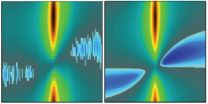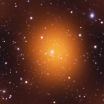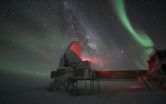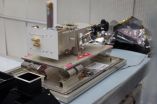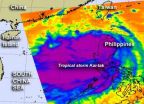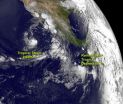(Press-News.org) A long-time staple of science fiction is the tractor beam, a technology in which light is used to move massive objects – recall the tractor beam in the movie Star Wars that captured the Millennium Falcon and pulled it into the Death Star. While tractor beams of this sort remain science fiction, beams of light today are being used to mechanically manipulate atoms or tiny glass beads, with rapid progress being made to control increasingly larger objects. Those who see major roles for optomechanical systems in a host of future technologies will take heart in the latest results from a first-of-its-kind experiment.
Scientists with the U.S. Department of Energy's Lawrence Berkeley National Laboratory (Berkeley Lab) and the University of California (UC) Berkeley, using a unique optical trapping system that provides ensembles of ultracold atoms, have recorded the first direct observations of distinctly quantum optical effects - amplification and squeezing - in an optomechanical system. Their findings point the way toward low-power quantum optical devices and enhanced detection of gravitational waves among other possibilities.
"We've shown for the first time that the quantum fluctuations in a light field are responsible for driving the motions of objects much larger than an electron and could in principle drive the motion of really large objects," says Daniel Brooks, a scientist with Berkeley Lab's Materials Sciences Division and UC Berkeley's Physics Department.
Brooks, a member of Dan Stamper-Kurn's research group, is the corresponding author of a paper in the journal Nature describing this research. The paper is titled "Nonclassical light generated by quantum-noise-driven cavity optomechanics." Co-authors were Thierry Botter, Sydney Schreppler, Thomas Purdy, Nathan Brahms and Stamper-Kurn.
Light will build-up inside of an optical cavity at specific resonant frequencies, similar to how a held-down guitar string only vibrates to produce specific tones. Positioning a mechanical resonator inside the cavity changes the
resonance frequency for light passing through, much as sliding one's fingers up and down a guitar string changes its vibrational tones. Meanwhile, as light passes through the optical cavity, it acts like a tiny tractor beam, pushing and pulling on the mechanical resonator.
If an optical cavity is of ultrahigh quality and the mechanical resonator element within is atomic-sized and chilled to nearly absolute zero, the resulting cavity optomechanical system can be used to detect even the slightest mechanical motion. Likewise, even the tiniest fluctuations in the light/vacuum can cause the atoms to wiggle. Changes to the light can provide control over that atomic motion. This not only opens the door to fundamental studies of quantum mechanics that could tell us more about the "classical" world we humans inhabit, but also to quantum information processing, ultrasensitive force sensors, and other technologies that might seem like science fiction today.
"There have been proposals to use optomechanical devices as transducers, for example coupling motion to both microwaves and optical frequency light, where one could convert photons from one frequency range to the other," Brooks says. "There have also been proposals for slowing or storing light in the mechanical degrees of freedom, the equivalent of electromagnetically induced transparency or EIT, where a photon is stored within the internal degrees of freedom."
Already cavity optomechanics has led to applications such as the cooling of objects to their motional ground state, and detections of force and motion on the attometer scale. However, in studying interactions between light and mechanical motion, it has been a major challenge to distinguish those effects that are distinctly quantum from those that are classical - a distinction critical to the future exploitation of optomechanics.
Brooks, Stamper-Kurn and their colleagues were able to meet the challenge with their microfabricated atom-chip system which provides a magnetic trap for capturing a gas made up of thousands of ultracold atoms. This ensemble of ultracold atoms is then transferred into an optical cavity (Fabry-Pferot) where it is trapped in a one-dimensional optical lattice formed by near-infrared (850 nanometer wavelength) light that resonates with the cavity. A second beam of light is used for the pump/probe.
"Integrating trapped ensembles of ultracold atoms and high-finesse cavities with an atom chip allowed us to study and control the classical and quantum interactions between photons and the internal/external degrees of freedom of the atom ensemble," Brooks says. "In contrast to typical solid-state mechanical systems, our optically levitated ensemble of ultracold atoms is isolated from its environment, causing its motion to be driven predominantly by quantum radiation-pressure fluctuations."
The Berkeley research team first applied classical light modulation to a low-powered pump/probe beam (36 picoWatts) entering their optical cavity to demonstrate that their system behaves as a high-gain parametric optomechanical amplifier. They then extinguished the classical drive and mapped the response to the fluctuations of the vacuum. This enabled them to observe light being squeezed by its interaction with the vibrating ensemble and the atomic motion driven by the light's quantum fluctuations. Amplification and this squeezing interaction, which is called "ponderomotive force," have been long-sought goals of optomechanics research.
"Parametric amplification typically requires a lot of power in the optical pump but the small mass of our ensemble required very few photons to turn the interactions on/off," Brooks says. "The ponderomotive squeezing we saw, while narrow in frequency, was a natural consequence of having radiation-pressure shot noise dominate in our system."
Since squeezing light improves the sensitivity of gravitational wave detectors, the ponderomotive squeezing effects observed by Brooks, Stamper-Kern and their colleagues could play a role in future detectors. The idea behind gravitational wave detection is that a ripple in the local curvature of spacetime caused by a passing gravitational wave will modify the resonant frequency of an optical cavity which, in turn, will alter the cavity's optical signal.
"Currently, squeezing light over a wide range of frequencies is desirable as scientists search for the first detection of a gravitational wave," Brooks explains. "Ponderomotive squeezing, should be valuable later when specific signals want to be studied in detail by improving the signal-to-noise ratio in the specific frequency range of interest."
The results of this study differ significantly from standard linear model predictions. This suggests that a nonlinear optomechanical theory is required to account for the Berkeley team's observations that optomechanical interactions generate non-classical light. Stamper-Kern's research group is now considering further experiments involving two ensembles of ultracold atoms inside the optical cavity.
"The squeezing signal we observe is quite small when we detect the suppression of quantum fluctuations outside the cavity, yet the suppression of these fluctuations should be very large inside the cavity," Brooks says. "With a two ensemble configuration, one ensemble would be responsible for the optomechanical interaction to squeeze the radiation-pressure fluctuations and the second ensemble would be studied to measure the squeezing inside the cavity."
INFORMATION:
This research was funded by the Air Force Office of Scientific Research and the National Science Foundation.
Lawrence Berkeley National Laboratory (Berkeley Lab) addresses the world's most urgent scientific challenges by advancing sustainable energy, protecting human health, creating new materials, and revealing the origin and fate of the universe. Founded in 1931, Berkeley Lab's scientific expertise has been recognized with 13 Nobel prizes. The University of California manages Berkeley Lab for the U.S. Department of Energy's Office of Science. For more, visit www.lbl.gov.
Good vibrations
Berkeley Lab and UC Berkeley researchers record first direct observations of quantum effects in an optomechanical system
2012-08-16
ELSE PRESS RELEASES FROM THIS DATE:
Team uncovers link between hormone levels and risk for metabolic disease
2012-08-16
JUPITER, FL, August 15, 2012 – Working with a national team of researchers, a scientist from the Florida campus of The Scripps Research Institute has shown for the first time a link between low levels of a specific hormone and increased risk of metabolic disease in humans.
The study, published online ahead of print in The Journal of Clinical Endocrinology & Metabolism, focuses on the hormone adropin, which was previously identified by Scripps Research Associate Professor Andrew Butler's laboratory during an investigation of obese and insulin-resistant mice. Adropin is ...
Giant galaxy cluster sets record pace for star creation
2012-08-16
Astronomers have found an extraordinary galaxy cluster — one of the largest objects in the universe — that is breaking several important cosmic records. The discovery of this cluster, known as the Phoenix Cluster, made with the National Science Foundation's South Pole Telescope, may force astronomers to rethink how these colossal structures, and the galaxies that inhabit them, evolve.
Follow-up observations made in ultraviolet, optical and infrared wavelengths show that stars are forming in this object at the highest rate ever seen in the middle of a galaxy cluster. The ...
Designing tiny molecules that glow in water to shed light on biological processes
2012-08-16
CORAL GABLES, FL (August, 15, 2012)--University of Miami scientists have developed a way to switch fluorescent molecules on and off within aqueous environments, by strategically trapping the molecules inside water-soluble particles and controlling them with ultraviolet light. The new system can be used to develop better fluorescent probes for biomedical research.
Previous studies have used water-soluble particles to bring organic molecules into water. What is novel about this system is the use of a photoswitching mechanism in combination with these particles.
The findings ...
NSF's South Pole Telescope discovers a galaxy cluster creating stars at a record pace
2012-08-16
A National Science Foundation-funded radio telescope in Antarctica has found an extraordinary galaxy cluster that may force astronomers to rethink how galaxy clusters and the galaxies that inhabit them evolve.
The galaxy cluster was discovered some 5.7 billion light years from Earth by the 10-meter wide South Pole Telescope (SPT) located at NSF's Amundsen-Scott South Pole Station in Antarctica, which is funded by NSF's Office of Polar Programs.
NSF manages the U.S. Antarctic Program, through which it coordinates all U.S research and required logistical support on the ...
Lunar reconnaissance orbiter spectrometer detects helium in moon's atmosphere
2012-08-16
Scientists using the Lyman Alpha Mapping Project (LAMP) spectrometer aboard NASA's Lunar Reconnaissance Orbiter (LRO) have made the first spectroscopic observations of the noble gas helium in the tenuous atmosphere surrounding the Moon.
These remote-sensing observations complement in situ measurements taken in 1972 by the Lunar Atmosphere Composition Experiment (LACE) deployed by Apollo 17.
Although designed to map the lunar surface, the LAMP team expanded its science investigation to examine the far ultraviolet emissions visible in the tenuous atmosphere above the ...
NASA sees large Tropical Storm Kai-tak headed for a landfall near Hong Kong
2012-08-16
Warnings are still in effect in the northern Philippines and now in Hong Kong, as Tropical Storm Kai-tak continues to drop heavy rainfall and move toward a landfall in China. NASA's Aqua satellite captured infrared data that shows a large area of strong thunderstorms that make up Kai-tak.
NASA's Aqua satellite captured infrared data on Kai-tak when it passed overhead on August 15 at 0517 UTC (1:17 a.m. EDT/1:17 p.m. local time, Hong Kong). Forecasters at the Joint Typhoon Warning Center noted that infrared satellite imagery shows the organization near the center of Kai-tak's ...
Lunar Reconnaissance Orbiter's LAMP spectrometer detects helium in moon's atmosphere
2012-08-16
Scientists using the Lyman Alpha Mapping Project (LAMP) aboard NASA's Lunar Reconnaissance Orbiter have made the first spectroscopic observations of the noble gas helium in the tenuous atmosphere surrounding the Moon. These remote-sensing observations complement in-situ measurements taken in 1972 by the Lunar Atmosphere Composition Experiment (LACE) deployed by Apollo 17.
Although LAMP was designed to map the lunar surface, the team expanded its science investigation to examine the far ultraviolet emissions visible in the tenuous atmosphere above the lunar surface, detecting ...
GOES-15 satellite sees fading Tropical Storm Hector and TD7's remnants
2012-08-16
Two tropical cyclones were spotted from NOAA's GOES-15 satellite today, August 15. Tropical Storm Hector continues to weaken in the Eastern Pacific Ocean, while the remnants of the Atlantic Ocean's Tropical Depression 7 are moving over Central America. NASA's GOES Project, located at NASA's Goddard Space Flight Center, Greenbelt, Md., uses the GOES-15 satellite data to create images and animations from the satellite. The NOAA GOES-15 satellite sits in a fixed orbit over the eastern U.S. and provides infrared and visible imagery of the Eastern Pacific Ocean basin continuously. ...
Continuous oral contraceptive pills offer women earlier pain relief
2012-08-16
Taking oral contraceptives continuously, rather than as traditionally prescribed for each cycle, provides earlier relief for moderate to severe menstrual cramps -- dysmenorrhea -- according to researchers at Penn State College of Medicine.
Dysmenorrhea occurs during menstruation, resulting from abnormal uterine contractions, increased sensitivity to pain and added pressure in the pelvic area. It is often accompanied by nausea, vomiting, diarrhea, headache and fatigue.
"Between 50 and 90 percent of women suffer from this condition, and it can really limit work, school, ...
Astronomers reassured by record-breaking star formation in huge galaxy cluster
2012-08-16
This press release is available in Spanish.
Until now, evidence for what astronomers suspect happens at the cores of the largest galaxy clusters has been uncomfortably scarce. Theory predicts that cooling flows of gas should sink toward the cluster's center, sparking extreme star formation there, but so far – nada, zilch, not-so-much.
The situation changed dramatically when a large international team of over 80 astronomers, led by Massachusetts Institute of Technology's Hubble Fellow Michael McDonald, studied a recently discovered (yet among the largest-known) galaxy ...
LAST 30 PRESS RELEASES:
New evidence challenges understanding of Parkinson’s disease
A new study reveals how embryos and the uterus “talk” during implantation
Cedars-Sinai reports heart attacks, general illness spiked after LA fires
PolyU develops ultra-stable, mucus-inspired hydrogel to boost gastrointestinal wound healing
Flour choice shapes sourdough microbial communities
Can a retinal implant reverse macular degeneration?
Feeding fungi plant remnants produces tasty protein to fortify vegan, vegetarian diets
New tech reduces false positives from breast ultrasounds
Drone-mounted lab monitors fertilizer runoff in real time
Short, light-intensity exercise boosts executive function and elevates mood in children
Jeonbuk National University researchers reveal new interface engineering strategy for efficient and stable back-contact solar cells
Tyrosinase drives hydroquinone-induced exogenous ochronosis: not HGD inhibition
UMass Amherst chemists develop unique tool for studying RNA
Disappointment alters brain chemistry and behavior
A built-in odometer: new study reveals how the brain measures distance
Stress-related brain signals drive risk of cardiovascular disease in people with depression and anxiety
New details on role of fat transport molecules in Alzheimer’s onset
Study illuminates how an antiviral defense mechanism may lead to Alzheimer’s disease
Spot the males: New gene-editing method could transform mosquito control
AI learns to build simple equations for complex systems
NAU team releases 13 years of detailed U.S. CO2 emissions data
Unveiling how sodium-ion batteries can charge faster than lithium-ion ones
How do childcare tax credits affect children’s long-term health?
Can an electronic nose detect indoor mold?
Do natural disasters have long-term impacts on mortality in older adults?
Modification improves sodium‐ion batteries as an alternative to lithium-ion batteries
Parasports provide a range of benefits for people with cerebral palsy
How does grandparental care affect children’s health?
Why are there so many Nordic mediators?
Young shark species more vulnerable to extinction
[Press-News.org] Good vibrationsBerkeley Lab and UC Berkeley researchers record first direct observations of quantum effects in an optomechanical system
